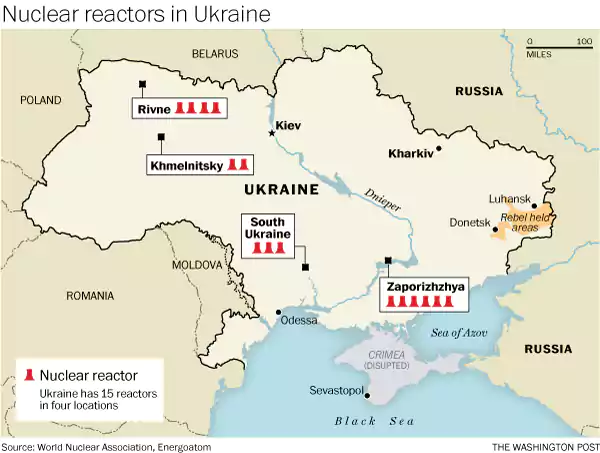
A worst-case scenario, if Europe’s largest nuclear power plant in Zaporizhia were to malfunction, this could have repercussions worse than Chernobyl.
The Zaporizhia coal power station is also located nearby. The Zaporizhia power plant is located around 200 km away from the War in Donbass combat zone, where fighting has become very severe in 2014. We in S2pU is very concerns the plant could be hit by heavy artillery from the fighting.
As Ukraine looks like a country teetering on the edge of war, there's an important factor to keep an eye on: The country's 15 nuclear reactors.
"There haven’t been many conflicts in states with nuclear power facilities in the past, so we're really entering unknown territory here," said Jeffrey Mankoff, Deputy Director of the Center for Strategic and International Studies' Russia and Eurasia Program. NATO has already shown its concern, sending a small team of civilian experts to Ukraine in April to advise the government on the safety of its infrastructure.
There is a historical component to the anxiety: In April 1986, a reactor of the Ukrainian nuclear power plant at Chernobyl exploded, causing the worst nuclear disaster in history, and a high rate of cancer among emergency workers and people living in the affected areas even today. Chernobyl happened in a time of peace: Today, Ukraine's reactors operate near a war zone.
Closest to the fighting is Zaporizhia Nuclear Power Station, which houses six separate reactors:
There are doubts about the safety mechanisms in place in these power plants. German public broadcaster ARD has warned that "a second Chernobyl disaster will be inevitable if the fighting in Ukraine cannot be stopped." Sergej Boschko, who heads Ukraine's nuclear regulatory agency, told ARD that "no nuclear power plant is protected against military attacks. They are not made for war, they are made for peace."
Hans-Josef Allelein, the chairman of Germany's Institute for Reactor Safety and Reactor Technology, said in an interview that these reports would indicate a "real danger" if true. "Such containers could theoretically be used as dirty bombs," Allelein explained. "In the end, the area around a nuclear power plant needs to be secured with a reliable air-defense system as it is for example installed at French power plants."
While that's a risk, other experts doubt things would go that far. "If Russia’s goal is to establish influence it doesn’t seem to make a lot of sense to cause a nuclear disaster with border-crossing mass casualties and radiation," Mankoff said, instead suggesting that a nuclear reactor is far more likely to be hit by accident than intentionally.
Unfortunately, even with these risks, shutting down the plants is unrealistic. According to the U.S. Energy Information Administration, Ukraine's energy consumption relies on nuclear energy by 18 percent, and coal contributes about 28 percent. Much of the rest of Ukraine's power supply comes from another troubled source: gas from Russia. "If the winter is cold and other countries don't jump in to help Ukraine, its energy resources could be exhausted by early spring," said Ilya Zaslavskiy, a Robert Bosch Fellow at the London-based Chatham House.
Source: https://www.washingtonpost.com



Comments powered by CComment